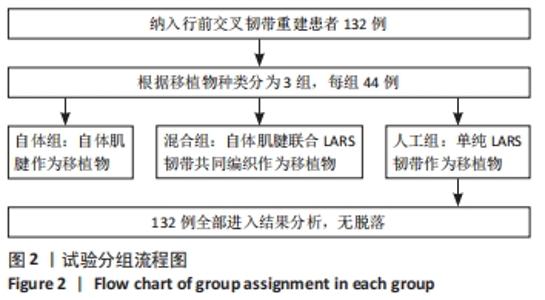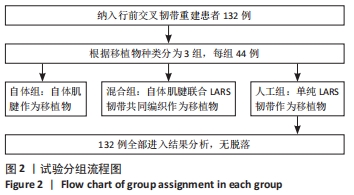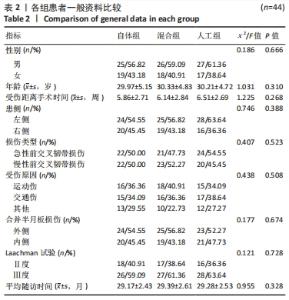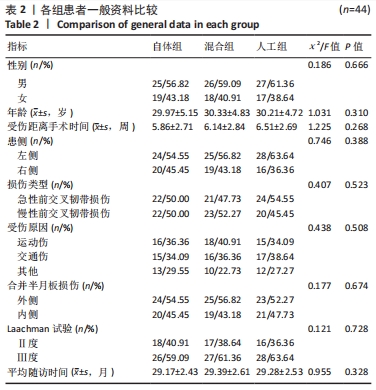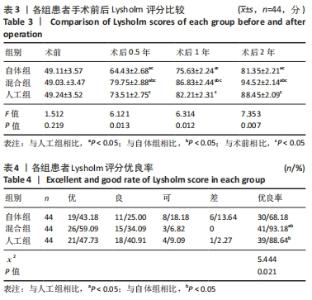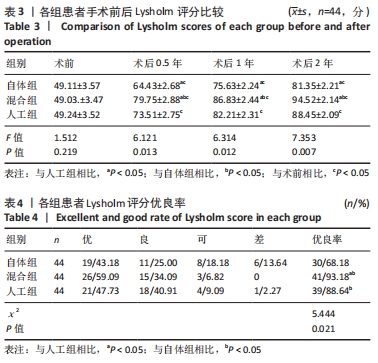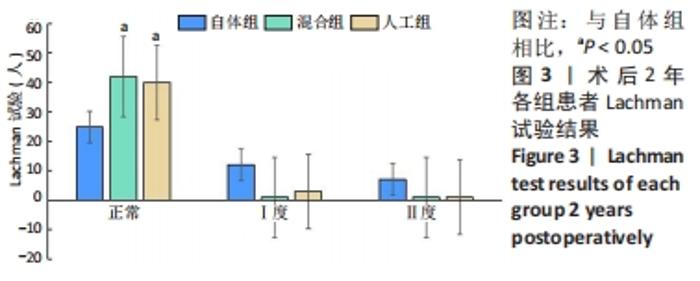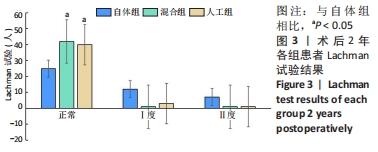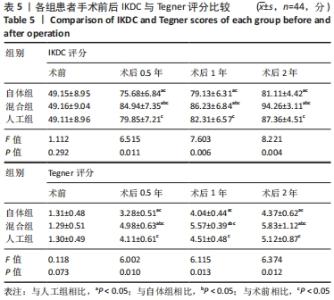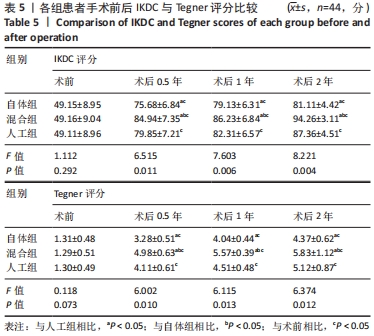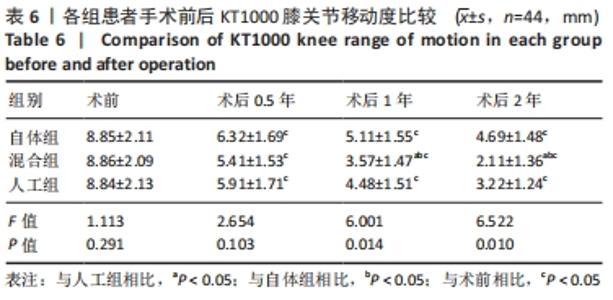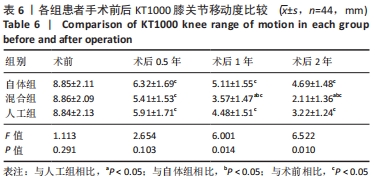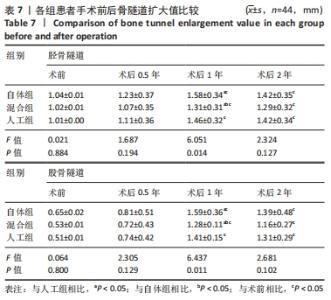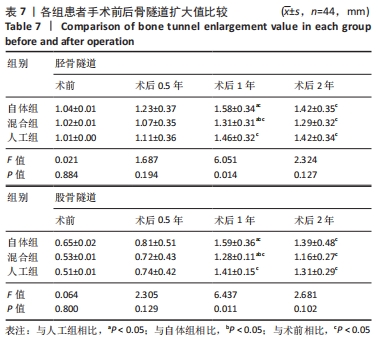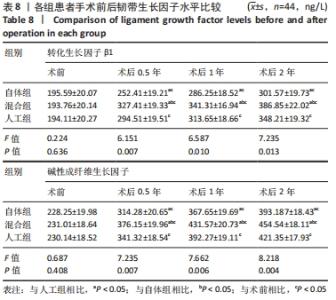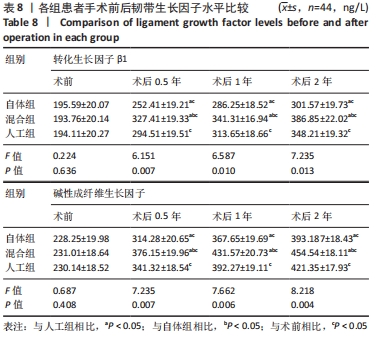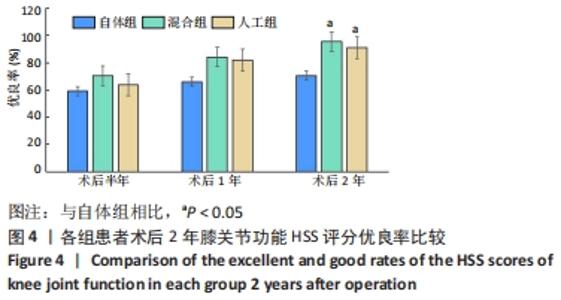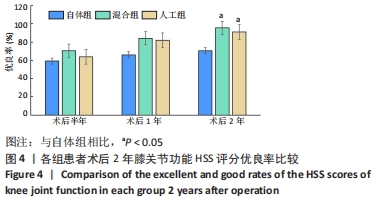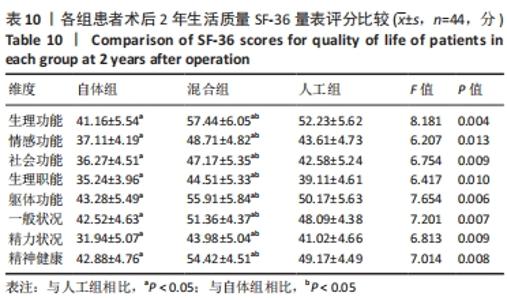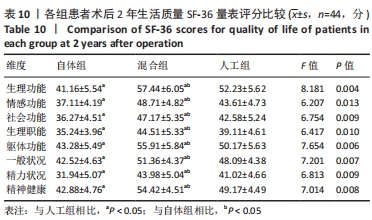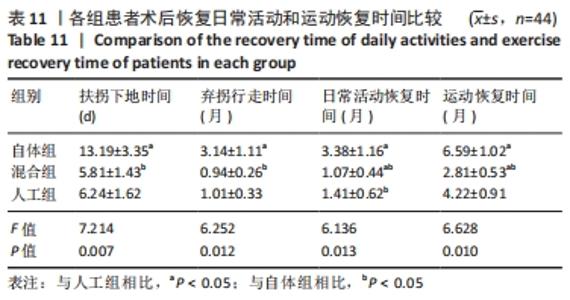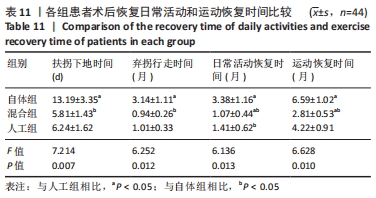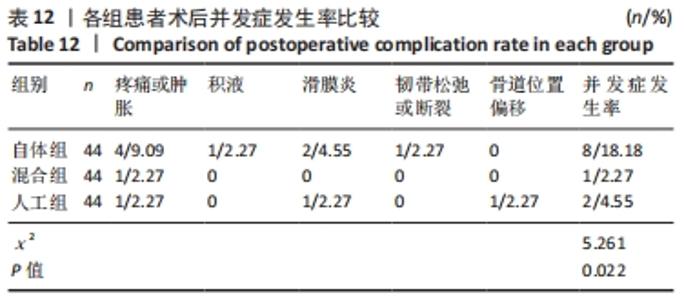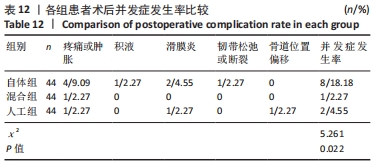Chinese Journal of Tissue Engineering Research ›› 2022, Vol. 26 ›› Issue (21): 3281-3290.doi: 10.12307/2022.633
Autologous, mixed and ligament advanced reinforcement system ligaments reconstruction of anterior cruciate ligament: evaluation of bone tunnel enlargement value, ligament growth factor and knee function
Cao Fuyang, Xu Jianzhong, Lu Shitao, Tan Jun, Jiang Xu, Yang Meng, Shi Jianming, Chang Yingjian
- First Affiliated Hospital of Zhengzhou University, Zhengzhou 450000, Henan Province, China
-
Received:2021-08-30Accepted:2021-09-30Online:2022-07-28Published:2022-01-27 -
Contact:Xu Jianzhong, MD, Chief physician, Master’s supervisor, First Affiliated Hospital of Zhengzhou University, Zhengzhou 450000, Henan Province, China -
About author:Cao Fuyang, Master candidate, First Affiliated Hospital of Zhengzhou University, Zhengzhou 450000, Henan Province, China
CLC Number:
Cite this article
Cao Fuyang, Xu Jianzhong, Lu Shitao, Tan Jun, Jiang Xu, Yang Meng, Shi Jianming, Chang Yingjian. Autologous, mixed and ligament advanced reinforcement system ligaments reconstruction of anterior cruciate ligament: evaluation of bone tunnel enlargement value, ligament growth factor and knee function[J]. Chinese Journal of Tissue Engineering Research, 2022, 26(21): 3281-3290.
share this article
Add to citation manager EndNote|Reference Manager|ProCite|BibTeX|RefWorks
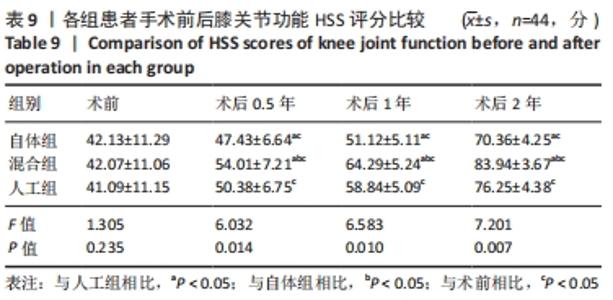
各组患者术前及术后0.5,2年的骨隧道扩大值比较差异均无显著性意义(P > 0.05)。相较于术前,各组患者术后1,2年的骨隧道扩大值均增加(P < 0.05)。混合组患者术后1年的骨隧道扩大值小于自体组、人工组(P < 0.05),自体组、人工组患者术后1年的骨隧道扩大值比较差异无显著性意义(P > 0.05)。 术前,各组患者转化生长因子β1、碱性成纤维生长因子水平比较差异均无显著性意义(P > 0.05)。各组术后0.5,1,2年的转化生长因子β1、碱性成纤维生长因子水平均高于术前(P < 0.05)。混合组患者术后0.5,1,2年的转化生长因子β1、碱性成纤维生长因子水平均高于自体组、人工组(P < 0.05),人工组较术后0.5,1,2年的转化生长因子β1、碱性成纤维生长因子水平均高于自体组(P < 0.05)。 2.9 各组患者手术前后膝关节功能HSS评分比较 见表9。"
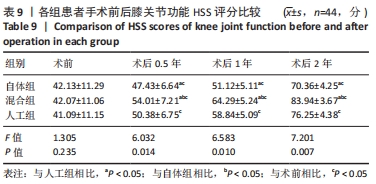
| [1] MARQUES JB, PAUL DJ, GRAHAM-SMITH P, et al. Change of Direction Assessment Following Anterior Cruciate Ligament Reconstruction: A Review of Current Practice and Considerations to Enhance Practical Application. Sports Med. 2020;50(1):55-72. [2] 李书振,王豪,韩杰,等.关节镜下早期与晚期自体肌腱重建前交叉韧带的对比研究[J].中国组织工程研究,2019,23(26):4170-4174. [3] 郑小飞,黄华扬,张余,等.关节镜下自体、异体骨-髌腱-骨与半腱肌腱3种重建前交叉韧带方法的疗效比较[J].中国组织工程研究与临床康复,2009,13(20):3903-3906. [4] 李从中.自体腓骨长肌腱和腘绳肌腱在关节镜下重建膝关节前交叉韧带临床研究[J].北华大学学报(自然科学版),2018,19(3):346-349. [5] WILLARD K, MANNION S, SAUNDERS CJ, et al. The interaction of polymorphisms in extracellular matrix genes and underlying miRNA motifs that modulate susceptibility to anterior cruciate ligament rupture. J Sci Med Sport. 2018;21(1):22-28. [6] 时剑辉,刘振中,张宇,等.LARS韧带与自体腘绳肌腱关节镜下重建前交叉韧带的疗效比较[J].黑龙江医药,2017,30(1):204-206. [7] 丁国成,刘铭,项良碧,等.人工韧带联合自体肌腱在前交叉韧带重建失败后翻修手术中应用[J].临床军医杂志,2017,45(8):809-812. [8] 陈伟,邹刚,刘毅.LARS韧带在前交叉韧带重建中的临床应用与关注热点[J].中国组织工程研究,2020,24(8):1287-1292. [9] 许荣梅.组织工程化韧带在前交叉韧带运动损伤修复中的作用[J].中国组织工程研究与临床康复,2011,15(21):3941-3944. [10] COLLINS KA, TURNER MJ, HUBBARD-TURNER T, et al. Gait and plantar sensation changes following massage and textured insole application in patients after anterior cruciate ligament reconstruction. Gait Posture. 2020; 81254-260. [11] 马军,温鹏,牛东生,等.关节镜下LARS人工韧带重建前交叉韧带中长期疗效观察[J].宁夏医学杂志,2018,40(10):884-886. [12] 姜文凯,张蜀平,刘锋,等.关节镜下采用自体髌韧带重建前交叉韧带的手术研究分析[J].临床医药文献电子杂志,2017,4(A0): 19642-19643. [13] 张家国,王景靓,邹喜君,等.关节镜下自体腘绳肌腱与同种异体肌腱重建前交叉韧带疗效及免疫排斥情况观察[J].临床和实验医学杂志,2018,17(19):2101-2104. [14] JIN JX, FANG PZ, HU ZW, et al. Comparison of the effectiveness of autologous grafts for anterior cruciate ligament reconstruction: A protocol for an overview of systematic review and network meta-analysis. Medicine (Baltimore). 2020; 99(43):e22832. [15] KAHLENBERG CA, NWACHUKWU BU, MEHTA N, et al. Development and Validation of the Hospital for Special Surgery Anterior Cruciate Ligament Postoperative Satisfaction Survey. Arthroscopy. 2020; 36(7): 1897-1903. [16] 白晓东,王耀霆,车琦,等.膝关节镜全内技术自体腘绳肌腱移植一期重建前、后十字韧带断裂[J].中华骨科杂志,2018,38(17): 1045-1054. [17] MISTRY H, METCALFE A, COLQUITT J, et al. Autograft or allograft for reconstruction of anterior cruciate ligament: a health economics perspective. Knee Surg Sports Traumatol Arthrosc. 2019;27(6):1782-1790. [18] MUñOZ-VALADEZ CI, ROMÁN-GALICIA J, JUáREZ-JIMÉNEZ HG. Reconstrucción simultánea de ambos ligamentos cruzados anteriores. Acta Ortopédica Mexicana. 2020;34(1):53-57. [19] 李立茵.关节镜下自体肌腱重建膝关节前交叉韧带的围手术期护理[J].当代护士(中旬刊),2019,26(2):29-30. [20] 张继荣,朱彬.膝关节前交叉韧带重建术中应用4、5束半腱肌、股薄肌自体移植物的临床效果[J].临床医学研究与实践,2018, 3(31):150-151. [21] 夏琪鹏.膝关节镜下采用两种自体材料重建前交叉韧带的临床效果对比[J].基层医学论坛,2018,22(10):1319-1320. [22] 覃华生,潘玮敏,李然,等.自体腘绳肌腱重建前交叉韧带后的康复策略[J].中国组织工程研究,2019,23(4):628-635. [23] LORD BR, EL-DAOU H, SABNIS M, et al. Biomechanical comparison of graft structures in anterior cruciate ligament reconstruction. Knee Surg Sports Traumatol Arthrosc. 2017;25(2):559-568. [24] MOUARBES D, MENETREY J, MAROT V, et al. Anterior Cruciate Ligament Reconstruction: A Systematic Review and Meta-analysis of Outcomes for Quadriceps Tendon Autograft Versus Bone-Patellar Tendon-Bone and Hamstring-Tendon Autografts. Am J Sports Med. 2019;47(14):3531-3540. [25] NISHIO Y, KONDO E, ONODERA J, et al. Double-Bundle Anterior Cruciate Ligament Reconstruction Using Hamstring Tendon Hybrid Grafts in Patients Over 40 Years of Age: Comparisons Between Different Age Groups. Orthop J Sports Med. 2018;6(5):2325967118773685. [26] 马永江,夏卫革.关节镜下保残与非保残重建前交叉韧带术后的临床疗效[J].临床医药文献电子杂志,2020,7(28):54-55. [27] 戴海东,明文义,陈林.关节镜下自体肌腱与异体肌腱重建前交叉韧带对关节稳定性的影响[J].现代实用医学,2020,32(11):1338-1340. [28] DIERMEIER T, TISHERMAN R, HUGHES J, et al. Quadriceps tendon anterior cruciate ligament reconstruction. Knee Surg Sports Traumatol Arthrosc. 2020;28(8):2644-2656. [29] SMITH C, AJUIED A, WONG F, et al. The use of the ligament augmentation and reconstruction system (LARS) for posterior cruciate reconstruction. Arthroscopy. 2014;30(1):111-120. [30] 邬韶霞,杨红.同伴教育对膝关节前交叉韧带损伤患者自体肌重建术后康复的影响[J].护理学报,2019,26(18):72-76. [31] 阿布都萨拉木·阿布都克力木,高志祥,买买提沙吾提阿吉·麦麦提,等.自体腘绳肌腱单束与双束重建前交叉韧带临床结果的Meta分析[J].骨科,2020,11(1):59-66. [32] YANG W, HUANG X, WANG S, et al. The long-term outcomes of different grafts in anterior cruciate ligament reconstruction: a network meta-analysis. J Orthopc Transl. 2021;26:16-30. [33] GEESLIN AG. Editorial Commentary: All-Inside Anterior Cruciate Ligament Reconstruction: In Pursuit of Ideal Graft Fixation. Arthroscopy. 2019;35(3):919-920. [34] 金钢,仲海燕,邵为,等.关节镜下自体腘绳肌腱与腓骨长肌腱单束重建前交叉韧带[J].中国矫形外科杂志,2019,27(24):2252-2256. [35] 陈金民,丁晶,陈穗生,等.关节镜下Rigidfix与Intrafix系统固定自体腘绳肌腱重建前交叉韧带[J].中国现代药物应用,2018,12(11): 69-71. [36] 徐刚,吴建明.关节镜下自体腘绳肌腱与同种异体肌腱重建膝关节交叉韧带的效果对比[J].江西医药,2018,53(12):1401-1403. [37] MURRAY MM, FLEMING BC, BADGER GJ, et al. Bridge-Enhanced Anterior Cruciate Ligament Repair Is Not Inferior to Autograft Anterior Cruciate Ligament Reconstruction at 2 Years: Results of a Prospective Randomized Clinical Trial. Am J Sports Med. 2020;48(6):1305-1315. [38] 蒋小东.康复训练在膝前交叉韧带损伤行关节镜下自体腘绳肌腱鞘内重建术后中的应用[J].中国民康医学,2019,31(3):153-154. [39] YANG X G, WANG F, HE X, et al. Network meta-analysis of knee outcomes following anterior cruciate ligament reconstruction with various types of tendon grafts. Int Orthop. 2020;44(2):365-380. [40] CAI J, ZHANG Q, CHEN J, et al. Electrodeposition of calcium phosphate onto polyethylene terephthalate artificial ligament enhances graft-bone integration after anterior cruciate ligament reconstruction. Bioact Mater. 2021;6(3):83-793. [41] ENGEBRETSEN L. Editorial Commentary: The Anterior Cruciate Ligament Cannot be Reliably Repaired: Studies With a Control Group are Needed! Arthroscopy. 2020;36(2):613-614. [42] 唐维才,苏万富.关节镜下自体腘绳肌腱重建前交叉韧带的临床效果观察[J].医学理论与实践,2019,32(9):1298-1300. [43] SONG G Y, ZHANG J, LI X, et al. Biomechanical and Biological Findings Between Acute Anterior Cruciate Ligament Reconstruction With and Without an Augmented Remnant Repair: A Comparative in Vivo Animal Study. Arthroscopy. 2016;32(2):307-319. [44] ANDONOVSKI A, TOPUZOVSKA S, SAMARDZISKI M, et al. The Influence of Anterior Cruciate Ligament Remnant on Postoperative Clinical Results in Patients with Remnant Preserving Anterior Cruciate Ligament Reconstruction. Open Access Maced J Med Sci. 2017;5(5):624-629. [45] CHEN J, KIM J, SHAO W, et al. An Anterior Cruciate Ligament Failure Mechanism. Am J Sports Med. 2019;47(9):2067-2076. [46] LIAN J, LIAN J, ZHONG M, et al. Comment on: Posterior cruciate ligament reconstruction for chronic lesions: clinical experience with hamstring versus ligament advanced reinforcement system as graft. Int Orthop. 2020;44(5):1011-1012. [47] WANG XM, JI G, WANG XM, et al. Biological and Biomechanical Evaluation of Autologous Tendon Combined with Ligament Advanced Reinforcement System Artificial Ligament in a Rabbit Model of Anterior Cruciate Ligament Reconstruction. Orthop Surg. 2018;10(2):144-151. [48] ALMEIDA AM, SANTOS SILVA PR, PEDRINELLI A, et al. Aerobic fitness in professional soccer players after anterior cruciate ligament reconstruction. PLoS One. 2018;13(3):e0194432. [49] VIATEAU V, MANASSERO M, ANAGNOSTOU F, et al. Biological and biomechanical evaluation of the ligament advanced reinforcement system (LARS AC) in a sheep model of anterior cruciate ligament replacement: a 3-month and 12-month study. Arthroscopy. 2013; 29(6):1079-1088. [50] GILLESPIE RJ, KNAPIK DM, AKKUS O. Biologic and Synthetic Grafts in the Reconstruction of Large to Massive Rotator Cuff Tears. J Am Acad Orthop Surg. 2016;24(12):823-828. [51] YUAN Z, CAO F, GAO C,et al. Decellularized Human Umbilical Cord Wharton Jelly Scaffold Improves Tendon Regeneration in a Rabbit Rotator Cuff Tendon Defect Model. Am J Sports Med. 2021; 3635465211055722. [52] SAVEH-SHEMSHAKI N, NAIR LS, LAURENCIN CT. Nanofiber-based matrices for rotator cuff regenerative engineering. Acta Biomater. 2019;94:64-81. [53] CHEN C, CHEN Y, LI M, et al. Functional decellularized fibrocartilaginous matrix graft for rotator cuff enthesis regeneration: A novel technique to avoid in-vitro loading of cells. Biomaterials. 2020;250:119996. |
| [1] | Wei Guoqiang, Li Yunfeng, Wang Yi, Niu Xiaofen, Che Lifang, Wang Haiyan, Li Zhijun, Shi Guopeng, Bai Ling, Mo Kai, Zhang Chenchen, Xu Yangyang, Li Xiaohe. Biomechanical analysis of non-uniform material femur under different loads [J]. Chinese Journal of Tissue Engineering Research, 2022, 26(9): 1318-1322. |
| [2] | Wu Liang, Wang Qiang, Wang Wenbo, Xin Tianwen, Xi Kun, Tang Jincheng, Xu Jingzhi, Chen Liang, Gu Yong. Risk factors for traumatic central cord syndrome underlying with cervical spondylotic myelopathy [J]. Chinese Journal of Tissue Engineering Research, 2022, 26(9): 1388-1394. |
| [3] | Xue Yadong, Zhou Xinshe, Pei Lijia, Meng Fanyu, Li Jian, Wang Jinzi . Reconstruction of Paprosky III type acetabular defect by autogenous iliac bone block combined with titanium plate: providing a strong initial fixation for the prosthesis [J]. Chinese Journal of Tissue Engineering Research, 2022, 26(9): 1424-1428. |
| [4] | Wang Shuo, Liu Wenying, Lü Chaofan, Li Jiacong, Geng Yi, Zhao Yungang. Cardioprotective effect of 3-nitro-N-methyl salicylamide on the isolated rat heart under cold ischemia preservation [J]. Chinese Journal of Tissue Engineering Research, 2022, 26(8): 1194-1201. |
| [5] | Li Zhiyi, He Pengcheng, Bian Tianyue, Xiao Yuxia, Gao Lu, Liu Huasheng. Bibliometric and visualized analysis of ferroptosis mechanism research [J]. Chinese Journal of Tissue Engineering Research, 2022, 26(8): 1202-1209. |
| [6] | Yang Shenglin, Pu Xingwei, Luo Chunshan, Yang Jianwen. Neuroprotective effects of tetrandrine preconditioning in rabbits with spinal cord ischemia-reperfusion injury [J]. Chinese Journal of Tissue Engineering Research, 2022, 26(8): 1223-1227. |
| [7] | Kan Houming, Fan Lijun, Chen Xuetai, Shen Wen. Application of platelet-rich plasma in neuropathic pain [J]. Chinese Journal of Tissue Engineering Research, 2022, 26(8): 1286-1292. |
| [8] | Wu Bingshuang, Wang Zhi, Tang Yi, Tang Xiaoyu, Li Qi. Anterior cruciate ligament reconstruction: from enthesis to tendon-to-bone healing [J]. Chinese Journal of Tissue Engineering Research, 2022, 26(8): 1293-1298. |
| [9] | Hu Wei, Xie Xingqi, Tu Guanjun. Exosomes derived from bone marrow mesenchymal stem cells improve the integrity of the blood-spinal cord barrier after spinal cord injury [J]. Chinese Journal of Tissue Engineering Research, 2022, 26(7): 992-998. |
| [10] | An Weizheng, He Xiao, Ren Shuai, Liu Jianyu. Potential of muscle-derived stem cells in peripheral nerve regeneration [J]. Chinese Journal of Tissue Engineering Research, 2022, 26(7): 1130-1136. |
| [11] | Fan Yiming, Liu Fangyu, Zhang Hongyu, Li Shuai, Wang Yansong. Serial questions about endogenous neural stem cell response in the ependymal zone after spinal cord injury [J]. Chinese Journal of Tissue Engineering Research, 2022, 26(7): 1137-1142. |
| [12] | Yuan Jing, Sun Xiaohu, Chen Hui, Qiao Yongjie, Wang Lixin. Digital measurement and analysis of the distal femur in adults with secondary knee valgus deformity [J]. Chinese Journal of Tissue Engineering Research, 2022, 26(6): 881-885. |
| [13] | Yi Xinrong, Jia Fuquan, He Xin, Zhang Shaojie, Ren Xiaoyan, Li Zhijun. Establishment of cervical bone age equation for male adolescents aged 8-16 years old in Hohhot based on thin-slice CT [J]. Chinese Journal of Tissue Engineering Research, 2022, 26(6): 954-958. |
| [14] | Yang Kuangyang, Wang Changbing. MRI evaluation of graft maturity and knee function after anterior cruciate ligament reconstruction with autogenous bone-patellar tendon-bone and quadriceps tendon [J]. Chinese Journal of Tissue Engineering Research, 2022, 26(6): 963-968. |
| [15] | Li Jie, Zhang Haitao, Chen Jinlun, Ye Pengcheng, Zhang Hua, Zhou Bengen, Zhao Changqing, Sun Youqiang, Chen Jianfa, Xiang Xiaobing, Zeng Yirong. Anterior cruciate ligament rupture and patellofemoral joint stability before sagittal and axial measurement using MRI [J]. Chinese Journal of Tissue Engineering Research, 2022, 26(6): 969-972. |
| Viewed | ||||||
|
Full text |
|
|||||
|
Abstract |
|
|||||
